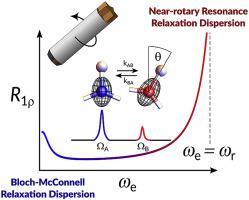Solid State Nuclear Magnetic Resonance ( IF 3.2 ) Pub Date : 2020-05-20 , DOI: 10.1016/j.ssnmr.2020.101665 Petra Rovó 1

|
This review describes two rotating-frame () relaxation dispersion methods, namely the Bloch-McConnell Relaxation Dispersion and the Near-rotary Resonance Relaxation Dispersion, which enable the study of microsecond time-scale conformational fluctuations in the solid state using magic-angle-spinning nuclear magnetic resonance spectroscopy. The goal is to provide the reader with key ideas, experimental descriptions, and practical considerations associated with measurements that are needed for analyzing relaxation dispersion and quantifying conformational exchange. While the focus is on protein motion, many presented concepts can be equally well adapted to study the microsecond time-scale dynamics of other bio- (e.g. lipids, polysaccharides, nucleic acids), organic (e.g. pharmaceutical compounds), or inorganic molecules (e.g., metal organic frameworks). This article summarizes the essential contributions made by recent theoretical and experimental solid-state NMR studies to our understanding of protein motion. Here we discuss recent advances in fast MAS applications that enable the observation and atomic level characterization of sparsely populated conformational states which are otherwise inaccessible for other experimental methods. Such high-energy states are often associated with protein functions such as molecular recognition, ligand binding, or enzymatic catalysis, as well as with disease-related properties such as misfolding and amyloid formation.
中文翻译:

固态弛豫分散技术的最新进展。
这篇评论描述了两个旋转框架()弛豫弥散方法,即Bloch-McConnell弛豫弥散和近旋转共振弛豫弥散,这使得能够使用魔角自旋核磁共振波谱研究固态的微秒时间尺度构象涨落。目的是为读者提供与之相关的关键思想,实验说明和实践考虑分析松弛分散和定量构象交换所需的测量值。虽然重点是蛋白质运动,但许多提出的概念也可以很好地适应研究其他生物(例如脂质,多糖,核酸),有机(例如药物化合物)或无机分子(例如,金属有机骨架)。本文总结了最新的理论和实验性固态NMR研究对我们对蛋白质运动的理解所做的重要贡献。在这里,我们讨论了快速MAS应用程序的最新进展,这些进展使得能够观察和稀疏构象状态的原子级表征,否则其他实验方法将无法实现。



























 京公网安备 11010802027423号
京公网安备 11010802027423号